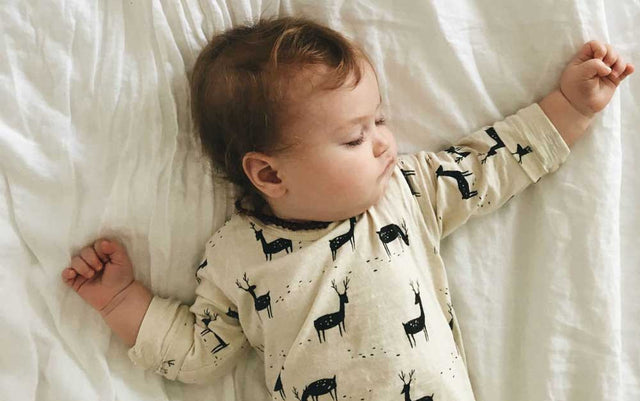What Do Babies Dream About?

What Do Babies Dream About?
Adults dream during REM (rapid eye movement) sleep and infants have loads of REM. So, it might be fair to assume that babies have tons of dreams. Perhaps they conjure up huge smiling faces, giant-tongued dogs licking their toes, or even their mama playing a game of peek-a-boo. Of course, babies can’t speak, so it’s natural to wonder: Do babies have dreams? And if so, what do babies dream about?
Do Babies Have Dreams?
Babies spend half of their sleep in REM (the cycle responsible for dreams), but neuroscientists believe that it serves a completely different purpose for newborns and infants than dreaming. When babies are in REM, it allows their brain to develop pathways, connections, and eventually, learn languages.
Do Babies Have Nightmares?
Since your baby doesn’t dream at this stage of brain development, it’s safe to assume that babies do not have nightmares either. Nightmares stem from exposure to trauma, an overactive imagination, and the normal stresses of everyday life.
Are you wondering, what do babies dream about? Good question, but the answer is…nothing! The “character of the self” hasn’t even made an appearance yet!
When Do Babies Start Dreaming?
So, when do babies start dreaming? The general consensus is that infants and babies start dreaming around the age of two. Psychologist David Foulkes studies children (from tots to teens) to bring the secrets of their dreams to the light of day. In his lab, he lets kids fall asleep and then wakes them 3 times a night—sometimes in REM and sometimes in NREM—and asks them to describe what they recall.
Foulkes’ findings are surprising…in how unsurprising they are. Basically, little kids have little dreams. But exactly what kids see while dreaming depends on their age. As children develop and grow, their dreams do too.
Toddler dreams are usually just snapshots, looking much more like a slideshow than a movie, when compared to the dreams of adults. They heavily feature animals and other familiar sights, like images of people eating. According to Foulkes, “Children’s dream life…seems to be similar to their waking imagination and narration,” he explains in his study, Children’s Dreaming and the Development of Consciousness. “Animals carry human concerns and readily become objects of identification.”
Kids ages 5-9 begin seeing moving images and characters in action. Dreams now include multiple events strung together, one after the other. Kids start developing greater ability to remember dreams. Still, that’s not always the case: When roused during REM sleep, 25% of the kids in Foulkes’ studies had no recollection of dreaming, a trend that continues through age 9.
Generally around age 8, children appear as central characters in their dreams. Dream narratives become more complex and longer. Not only do children dream up the action as it unfolds, they also have thoughts and feelings within the dream.
Final Thoughts: What Do Babies Dream About?
You no longer have to wonder, what do babies dream about anyway? It turns out that infants and babies don’t start having vivid dreams until around the age of two. Only when their brains develop well past this stage, will babies start having dreams and nightmares. And even later to retain them in their memory. So, if your baby seems to be in a stressful state while sleeping or is upset upon waking, there may be other factors at play [Read: the fourth trimester]. SNOO Smart Sleeper responds to these episodes and keeps babies calm by mimicking the sensations of the womb. Learn more about SNOO here.